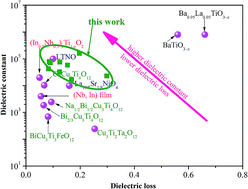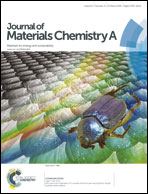Colossal permittivity in ceramics of TiO2 Co-doped with niobium and trivalent cation†
Abstract
The appearance of colossal permittivity (CP) materials broadens the choice of materials for energy-storage applications. Here we report colossal permittivity in ceramics of TiO2 co-doped with niobium and trivalent cation {i.e., (A0.5Nb0.5)xTi1−xO2, A = Bi, Pr, Dy, Sm, Gd, Yb, Ga, Al or Sc}, in particular in the (Bi0.5Nb0.5)xTi1−xO2 ceramic system that was selected as a candidate material. A very large dielectric constant (εr ∼ 4.2 × 104) and a low dielectric loss (tan δ ∼ 8.3%) were observed for (Bi0.5Nb0.5)xTi1−xO2 ceramics when measured at 1 kHz. Moreover, the addition of Bi and Nb can enhance the temperature stability (between −125–200 °C) and frequency stability (between 102 to 106 Hz) of εr and tan δ. The electron-pinned defect-dipoles are considered to be responsible for both their high εr and low tan δ, which is consistent with changes of valence states determined by X-ray photoelectron spectroscopy. We believe that the TiO2 ceramics as a CP material constitute one of the most promising candidates for high-energy-density storage applications.


 Please wait while we load your content...
Please wait while we load your content...